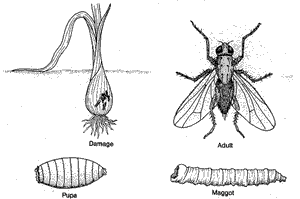 |
The Cabbage Maggot Is Also Called Root Maggot
Small, white legless worm with a blunt rear end, about 1/4 to 1/3 inch long, the larva of adult resembling a housefly. Flies lay eggs in the soil at the base of the stem of the vulnerable plant. The maggot tunnels into plant roots and stems; causes wilting and bacterial disease such as blackleg or soft rot may result.
Vulnerable Plants - Broccoli, brussels sprouts, cabbage, cauliflower, kohl rabi, radishes, turnips, rutabaga, peas, and Chinese cabbage; especially at seedling stage.
Emergence Times - Cabbage maggots emerge in early spring.
Symptoms Of Cabbage Maggot
Brown, sometimes slimy, tunnels in plant tissue. These tunnels can serve as entryways for bacterial and fungal diseases. Stem damage below soil. Seedlings become yellow. Plant is stunted and lacks vigor. Plant wilts during heat of the day, and eventually dies.
Early Warning Devices Called Trap Crops - The two most effective trap crops for cabbage maggots or root maggots are radishes and turnips. The radishes and turnips draw the maggot fly (parent of the worm). Once the trap crop is heavily infested, you must pull and compost it immediately or destroy it. With turnips, you can harvest the greens, and destroy the tubers.

